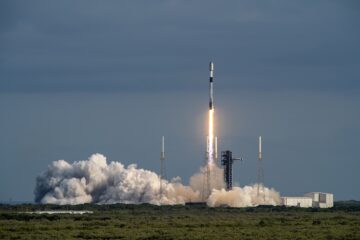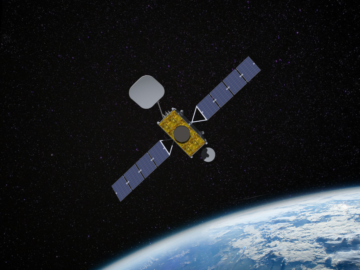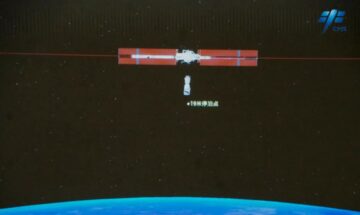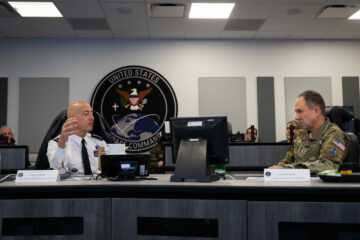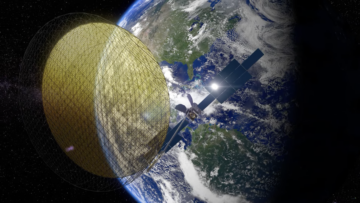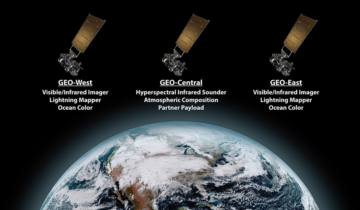COLORADO SPRINGS — The National Reconnaissance Office, the secretive U.S. intelligence agency responsible for operating the country’s spy satellites, is developing a more diverse fleet of satellites alongside an overhaul of its ground systems.
Troy Meink, principal deputy director of the NRO, said the agency is looking to develop a more diverse satellite architecture, including smaller and more maneuverable models, to improve its intelligence gathering across a wider range of orbits and mission profiles.
“We are pushing the boundaries to ensure we stay on the leading edge of innovation,” Meink said April 9 in a keynote speech at the 39th Space Symposium. “Over the next decade, we will continue to increase the number of satellites operating across multiple orbits, not just large systems that are the traditional hallmark of the NRO, but also smaller proliferated systems.”
In parallel with the changes to its space-based systems, the NRO is also overhauling its satellite ground architecture, investing heavily in new technologies like artificial intelligence (AI) and machine learning to help process the flood of data coming from its expanding satellite network.
“Expanding our overhead architecture will provide greater revisit rates, increased coverage, and more timely delivery of information,” Meink said. “This will make our collection more agile, eliminate single points of failure and will make our constellations more resilient.”
Ground systems
A more diverse space architecture will allow the NRO “to collect an order of magnitude more data,” he said. “So this means ground operations must evolve as well. I think this is actually one of the biggest challenges we face. … It’s not the bits that matter. It’s how the bits get organized into useful information that’s important.”
The NRO’s push to modernize its ground systems started several years ago, said Joshua Perrius, senior vice president of Booz Allen Hamilton. The company is a support contractor to the NRO for ground systems modernization.
“The goal is more automated tasking and collection based on data models and less on human planned activities,” Perrius told SpaceNews.
“The NRO is seeking more advanced data processing and exploitation capabilities on the ground to make sense of all the data it’s collecting,” he said. “They have to be able to rapidly task, re-task, and exploit data from a more diverse and resilient constellation, while also leveraging the latest AI and automation tools,” said Perrius.
He said AI and machine learning algorithms can help to identify critical information and generate actionable intelligence much faster than traditional methods.
While the specific details of the NRO’s plans are classified, Perrius noted, this shift towards a more diverse satellite fleet and AI-powered ground systems signifies a major transformation for the intelligence agency.
The NRO’s fleet includes imaging satellites that take high-resolution pictures of the Earth’s surface, signals intelligence satellites that intercept and collect electronic communications, and others that gather information about objects by analyzing radio frequencies and other emissions.
Access to ‘hostile territory’
“Millions of people count on us everyday,” Meink said at the Space Symposium. “Civilian customers depend on space collection to assist them with natural disasters, help predict climate change, and help relief agencies determine how and where to deliver humanitarian aid.”
The Department of Defense and the intelligence community, he added, depend on the NRO capabilities, for example, for geolocation data and high-resolution imagery. “The NRO systems are often the only tools able to access hostile territory or rugged terrain so we can collect critical information.”
- SEO Powered Content & PR Distribution. Get Amplified Today.
- PlatoData.Network Vertical Generative Ai. Empower Yourself. Access Here.
- PlatoAiStream. Web3 Intelligence. Knowledge Amplified. Access Here.
- PlatoESG. Carbon, CleanTech, Energy, Environment, Solar, Waste Management. Access Here.
- PlatoHealth. Biotech and Clinical Trials Intelligence. Access Here.
- Source: https://spacenews.com/nro-eyes-diverse-satellite-fleet-and-ai-powered-ground-systems-in-modernization-push/
- :is
- :not
- :where
- 1
- 10
- 12
- 13
- 17
- 19
- 24
- 300
- 41
- 46
- 5
- 50
- 6
- 9
- a
- Able
- About
- access
- across
- actionable
- activities
- actually
- added
- advanced
- again
- agencies
- agency
- agile
- ago
- AI
- AI-powered
- Aid
- Alert
- algorithms
- All
- allen
- allow
- alongside
- also
- an
- analyzing
- and
- April
- architecture
- ARE
- artificial
- artificial intelligence
- Artificial intelligence (AI)
- AS
- assist
- At
- Automated
- Automation
- based
- BE
- Biggest
- bits
- boundaries
- but
- button
- by
- CAN
- capabilities
- challenges
- change
- Changes
- classified
- Climate
- Climate change
- Close
- collect
- Collecting
- collection
- coming
- Communications
- community
- company
- continue
- Contractor
- couldn
- count
- country’s
- coverage
- critical
- Customers
- data
- data processing
- day
- decade
- Defense
- deliver
- delivery
- Department
- department of defense
- depend
- deputy
- details
- Determine
- develop
- developing
- Director
- disasters
- diverse
- Edge
- Electronic
- eliminate
- Emissions
- ensure
- error
- Ether (ETH)
- everyday
- evolve
- example
- expanding
- Exploit
- exploitation
- Eyes
- Face
- Failure
- false
- faster
- FLEET
- flood
- For
- from
- gather
- gathering
- generate
- get
- goal
- greater
- Ground
- Hamilton
- Have
- he
- heavily
- help
- Hidden
- high-resolution
- hostile
- How
- HTTPS
- human
- Humanitarian
- Humanitarian Aid
- i
- identify
- Imaging
- important
- improve
- in
- includes
- Including
- Increase
- increased
- information
- Innovation
- Intelligence
- into
- investing
- ITS
- joshua
- journalist
- just
- Keynote
- large
- latest
- leading
- learning
- less
- leveraging
- like
- List
- looking
- machine
- machine learning
- magnitude
- major
- make
- Matter
- max-width
- means
- methods
- Military
- Mission
- models
- modernization
- modernize
- more
- much
- multiple
- must
- National
- Natural
- network
- New
- New technologies
- Newsletter
- next
- noted
- number
- objects
- of
- Office
- often
- on
- ONE
- only
- operating
- Operations
- or
- order
- Organized
- Other
- Others
- our
- Overhaul
- overhead
- page
- Parallel
- People
- Pictures
- planned
- plans
- plato
- Plato Data Intelligence
- PlatoData
- please
- points
- pop-up
- predict
- president
- Principal
- process
- processing
- Profiles
- provide
- publish
- Push
- Pushing
- Radio
- range
- rapidly
- Rates
- RE
- relief
- resilient
- responsible
- s
- Said
- satellite
- satellites
- secretive
- seeking
- senior
- sense
- several
- shift
- signals
- signifies
- single
- smaller
- So
- Space
- space-based
- specific
- speech
- started
- Status
- stay
- subscription
- support
- Surface
- Symposium
- Systems
- T
- Take
- Task
- Technologies
- terrain
- territory
- than
- that
- The
- Them
- There.
- Think
- this
- timely
- to
- told
- tools
- towards
- traditional
- Transformation
- true
- try
- Tuesday
- u.s.
- us
- useful
- veteran
- vice
- Vice President
- was
- we
- WELL
- while
- wider
- will
- with
- years
- you
- Your
- zephyrnet




